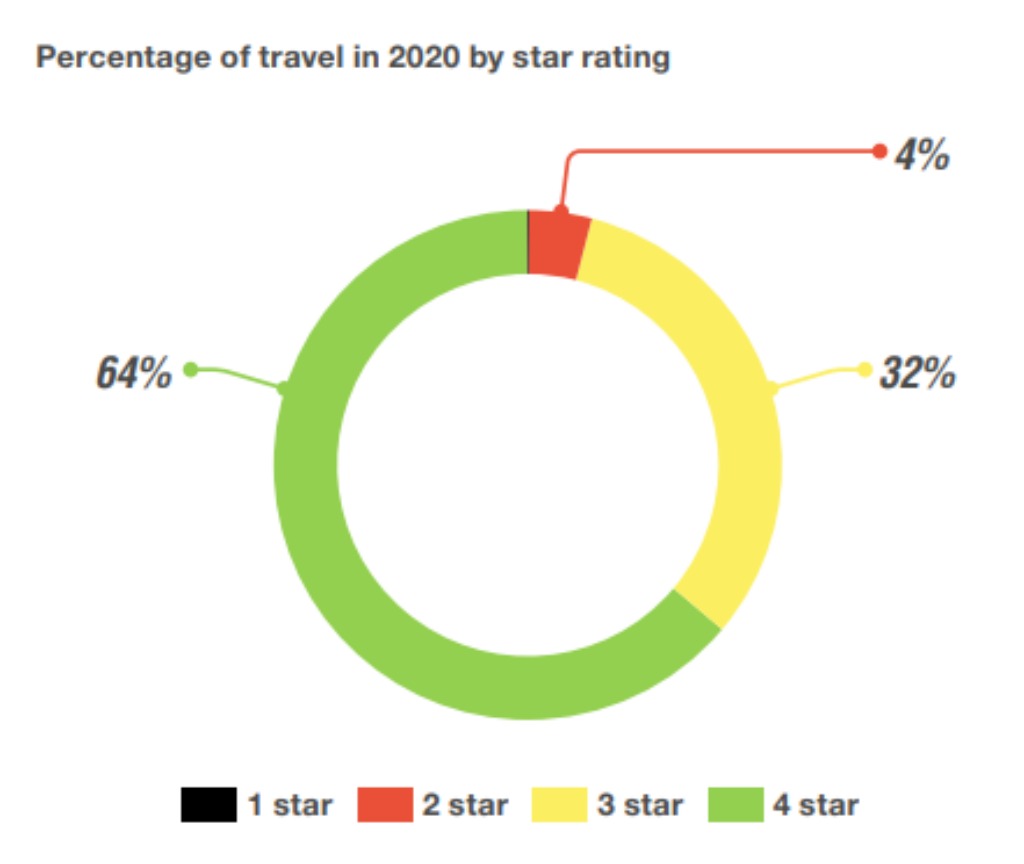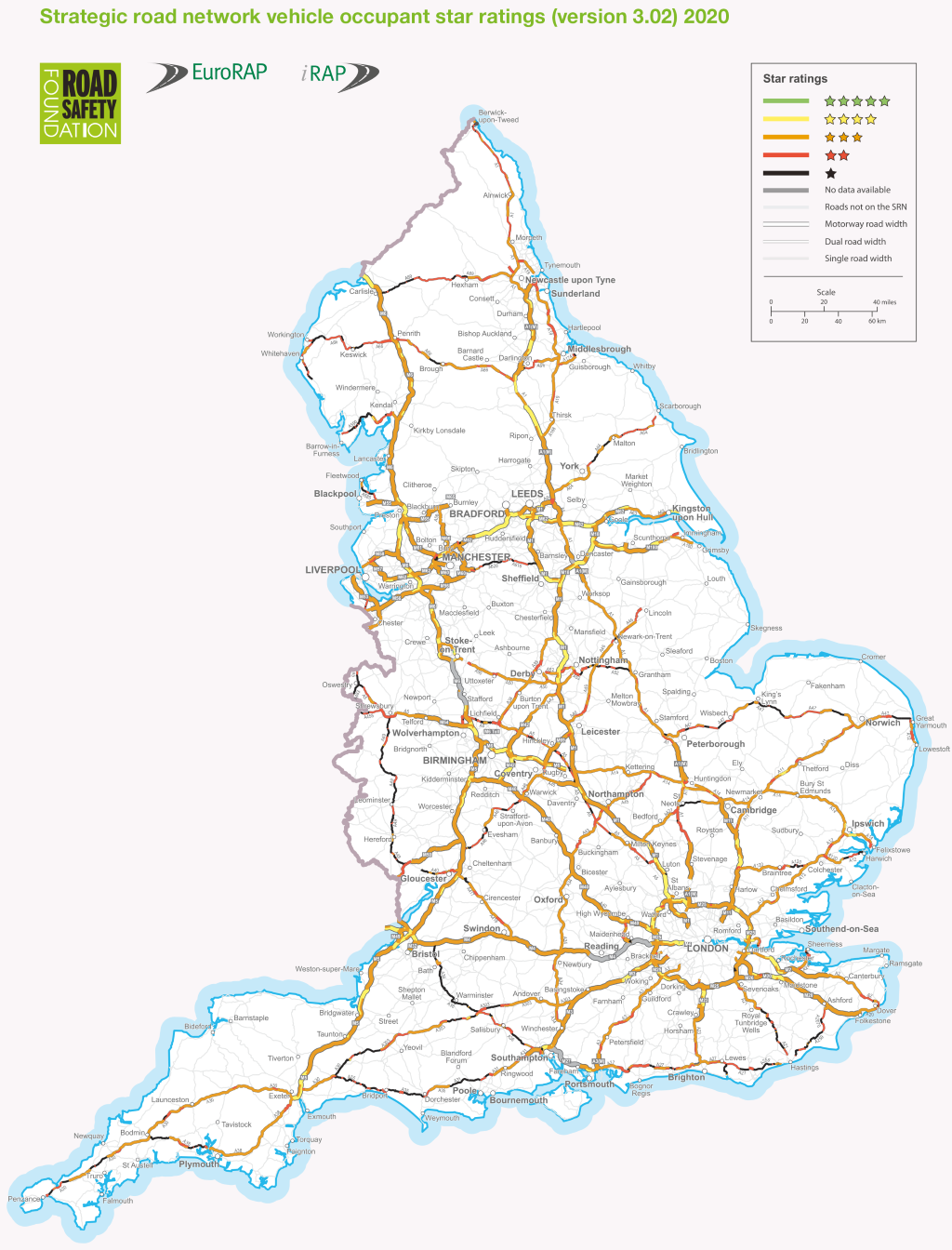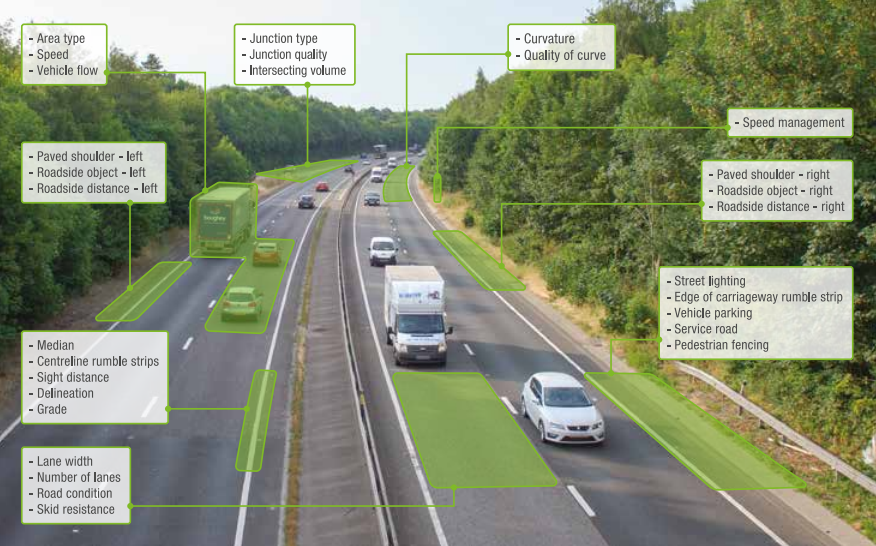National Highways has recently released its Strategic Road Network Star Rating Report showing it exceeded its 2020 policy target to achieve 90% of travel on its network on roads rated 3-star or better, with an impressive result of 96%.
National Highways, formerly Highways England, is a government-owned company charged with operating, maintaining and improving motorways and major A roads in England. It also sets highway standards used by all four UK administrations, through the Design Manual for Roads and Bridges.
National Highways uses iRAP’s Star Rating Protocol to measure how safe its roads are, undertaking independently assessed road network surveys every five years to calculate the star ratings.
The 2020 results were better than forecast when the 2015 results were published. Almost two-thirds of travel on National Highways’ network is now on 4-star roads when using Version 1.0 of the iRAP Model (the model version on which the 2020 target was set).


Almost all travel on motorways, and the majority of traffic on dual carriageway A-roads (that together account for the majority of travel on National Highways’ network), is now on roads rated 3-star or better. For single carriageway roads, that account for 6% of travel on the strategic road network, travel is primarily on 1- or 2-star rated roads.
The star rating model estimates where collisions are likely to occur in the future, given a location’s risk factors.

It suggests treatments known to address the collision risk identified, and which are most likely to be cost-effective in reducing that risk.
These are combined into the Safer Roads Investment Plan (SRIP).
At a network level, the SRIP information can help with planning the level of investment needed and strategic approach. For example, many of the cost-effective countermeasures can be delivered via maintenance and renewals.
At the individual route level, the data and countermeasure recommendations can provide road safety engineers with ideas to help with planning, appraisal and prioritisation of safety countermeasures.
The approach also enables road safety engineers to model the road safety impact of different treatment scenarios.
New designs can be star rated in advance, and star rating performance requirements, such as setting a minimum star rating standard, can be built into contracts to challenge design teams.
The report highlights star rating improvement case studies such as the A19 Coast Road junction:

National Highways’ Chief Engineer Mike Wilson said, “Our road safety management approach, is based on the principle that people’s life and health should not be compromised by their need to travel.
“At the heart of this approach is a strategy that leads to safe drivers, in safe vehicles, on safe roads. How we design, build, maintain and operate safer roads is vital to helping to minimise harm.
“The iRAP star rating protocols are one way we measure how safe our roads are. These results show we are making improvements to our network safety through activities that are now built into our everyday work.
“We are proud that we have exceeded our target that at least 90% of travel on our network was on roads which were rated 3-star or better in 2020.
“iRAP is not just about measurement though. We will use the data gathered to calculate the 2020 star rating baseline to drive our safer roads work to inform strategic planning, investment decisions and prioritisation for route safety as we look forward to 2025 and beyond,” he said.
National Highways is investing in its staff to support these activities, providing them with training on how to use the iRAP tools as part of their day-to-day activities. This will help to ensure that the star ratings and the data that underpin them can be used to drive activity throughout the business.
National Highways is also using iRAP’s Star Rating for Designs tool where new roads are being designed, helping to ensure that they are built to a 3-star rated standard or higher to optimise the potential safety benefits of major projects.
In 2019, the Arup design team for the A417 ‘missing link’ undertook this approach applying it to their designs.
It helped them to identify that there was high risk where an access road joined the main carriageway.
Alongside other factors this prompted them to review alternative design options to understand their impact on star ratings and on expected fatal and serious injuries.
This optioneering resulted in them amending the gradient of the road allowing them to reconfigure the access road removing the need for a junction with the main carriageway.
The new design resulted in a much-reduced expected number of fatal and serious injuries and an improvement in the star rating.
Using the iRAP star rating will help National Highways to meet the requirements of EU Directive 2019/1936 on Road Infrastructure Safety Management (RISM).
The directive requires a network-wide route assessment to be carried out by 2024. This will measure the safety performance of roads targeting investment based on risk and the potential to reduce the greatest number of fatally and seriously injured casualties.
National Highways’ vision for road safety is ambitious – for zero harm on the strategic road network – and to achieve that, it has committed to reducing deaths and serious injuries on the strategic road network by 50% by 2025.
It is developing performance indicators to support the achievement of this target, including a possible measure of infrastructure safety using the iRAP model.
In addition to its network focus, National Highways also contributes to the on-going development of the iRAP model.
In recent years, it has worked with partners to consider how the model reflects the use of technology such as variable speed limits for managing road space.
The National Highways’ iRAP programme has also helped in the development of a route review tool which will be made available across the world and engineers to determine the road safety impact of their planned treatment solutions.
“We look forward to continuing our work with the Road Safety Foundation, iRAP and other road safety experts around the world to deliver our vision of zero harm on our roads.” Mr Wilson said.
Download a copy of the 2020 National Highways Strategic Road Network Star Rating Report here.


















